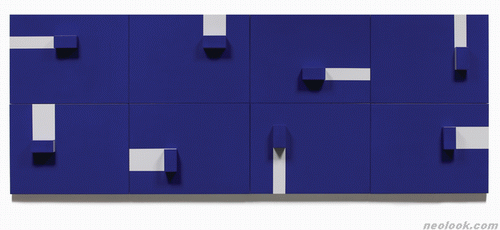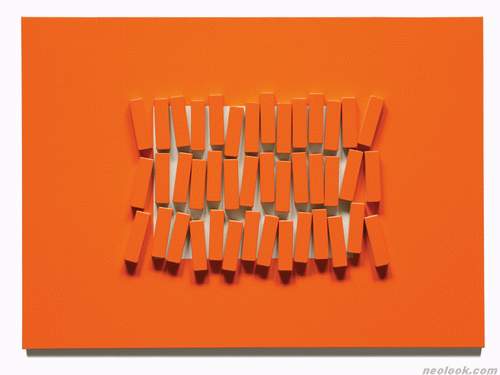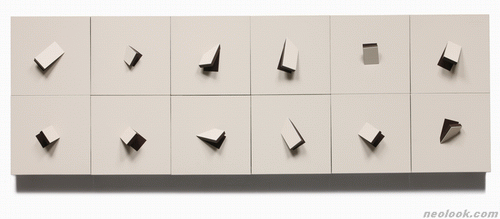- ● homepage
- ● archives
- ● restoration
- ● books
- ● big banners
- ● post board
- ■ neo's search
- ■ about us
- ■ 게재방법 안내
- 개인정보처리방침

- [email protected]
- Tel. 02_335_7922
- Fax. 02_335_7929
- 10:00am~04:30pm
- 월요일~금요일
- 3/3(월) 대체공휴일

표면의 변성(變性) Denatured Surface
이계원展 / LEEKEWON / 李桂園 / painting 2008_0910 ▶ 2008_0922
● 위 이미지를 클릭하면 네오룩 아카이브 Vol.20061225b | 이계원展으로 갑니다.
초대일시 / 2008_0910_수요일_05:00pm
관람시간 / 10:00am~07:00pm / 14,16일 휴관
통인옥션갤러리 TONG-IN Auction Gallery 서울 종로구 인사동길 32 (관훈동 16번지) 통인빌딩 5층 Tel. +82.(0)2.733.4867 www.tongingallery.com
이계원의 동질이형(Allotropism): 표면 파괴의 환영을 통해 오브제처럼 보이는 캔버스 회화 ● 이계원은 2001년부터 "동질이형"이라는 제목/주제로 작업을 해오고 있다. 작품마다 조금씩 차이는 있으나 대부분의 작품들은 기하학적 형태로 반복하여 캔버스를 백색 상태로 남기면서 화면을 단색으로 균일하게 채색한 후 백색 부분들 위에 각각 표면이 그 형태에 일치하는 모양의 나무를 화면과 평행하게 또는 비스듬하게 세워 붙인 것이다. 이 때 덧붙인 나무의 전면이 캔버스 바탕 화면과 같은 색이어서 기하학적인 오브제들이 마치 잘려진 캔버스가 화면 밖으로 나온 듯이 보인다. 어떤 작품에서는 백색 부분이 화면의 색보다 어두운 색으로 칠해지기도 하는데, 이럴 경우에는 이 부분이 그 위에 덧붙인 기하학적인 오브제의 그림자처럼 보이기도 한다. 몇몇 작품은 화면에서 백색 부분으로 남긴 크기만큼의 나무의 전면을 바탕색과 같은 색으로 칠한 후 가늘고 긴 기하학적인 오브제로 잘라 그것을 캔버스의 백색 부분이 드러나도록 방향의 변화를 주면서 덧붙인 것이다. 이러한 작품의 경우 때에 따라서는 덧붙인 나뭇조각들이 직사각형 캔버스의 경계(limit)를 넘기도 한다.

- 이계원_Allotropism_캔버스, 나무에 아크릴채색_80.5×213cm_2008
"동질이형"은 '두개 이상의 서로 다른 외형을 가진 물질들이 동일한 성분을 공유하고 있다'는 것을 지칭하는 용어이다. 이계원은 1997년 유학을 위해 뉴욕에 도착한 후 처음에는 다인종 경험을 통해 충격을 받았으나 시간이 지나면서 여러 인종의 뉴욕 거주자들과의 만남을 통해서 그들 사이의 공통적 특성들을 발견하게 됨으로써 그들 사이에 외형적 차이만이 존재한다고 생각하게 되었고, 이를 통해서 동질이형 개념을 착안했다고 적고 있다. 이러한 그의 작품에서 동질(同質), 즉 작품의 공통적인 성분(substance)은 직사각형의 캔버스, 같은 색으로 균일하게 물감이 발라진 캔버스 표면(surface)과 그 위에 덧붙은 나무토막의 형태, 재료와 색의 공통성이고, 이형(異形)은 그것들이 '변주'되어 배치될 때 서로 다른 모습으로 보이는 것이라고 할 수 있다. ● 이에 따라 이계원의 작품의 가장 기본적인 특징들은 직사각형 캔버스, 단색으로 칠해진 화면과 그것을 통해서 생겨난 - 작가는 그가 추구하는 표면과는 다르다고 보는 - 화면의 평면성이다. 이들은 너무도 잘 알려져 있는 모더니즘 이론가 클레멘트 그린버그의 회화 매체의 조건들(직사각형 캔버스, 평면성과 물감)을 상기시킨다. 미국에서는 이러한 회화의 조건들이 모더니스트 회화에 의해 적극적으로 강조되면서 그것과 그 전에 있었던 추상표현주의 회화의 감정의 충일에 대한 반대로 미니멀리스트 오브제(object)가 등장하게 된다. ● 1967년 마이클 프리드는 "미술과 사물성(Art and Objecthood)"이라는 글에서 이 상황을 다음과 같이 설명하고 있다. 그가 리터럴리스트라 부르는 미니멀리스트들은 회화의 특징을 "관계적 성격"과 "환영의 불가피함"으로 보았다는 것이다. 프리드는 회화의 위와 같은 특징의 기원을 직사각형이라는 지지대(support)의 형태(shape)의 강조로 설명하는 도날드 저드의 주장을 인용한다. 후자에 의하면 회화는 "모호한 완전체(a vague whole)"가 아니라 "분명한 완전체(a definite whole)"로 보이기를 원하고, 이를 위해서 화면 위의 부분들은 지지대의 직사각형 모양(shape)을 고려하면서 그 위와 안에서 배열하게 된다는 것이다. 프리드는 이러한 리터럴리스트의 입장에서 보면 60년대 전반 모더니스트 회화가 "지지대(support)의 직사각형 형태(shape)"를 강조한 것은 "회화가 지친 것"이었고, 프랭크 스텔라처럼 지지대의 형태가 직사각형을 피한 "shaped" 캔버스의 등장은 "고통의 연장"으로 보일 수 있다고 설명하였다. ● 이계원의 "동질이형" 작품들은 바로 이러한 논의들 사이에 놓여있는 듯이 보인다. 그 자신이 사용하는 용어들과 위에서 나열한 특징들을 지닌 그의 작품은 서양, 엄밀하게는 미국 미술사에서 미니멀리즘 오브제의 고안자들과 옹호자들이 "모더니스트 페인팅"의 딜레마를 비판하던 기준들과 연결되어 있다. 그의 작품의 이러한 미술사적 위치는 그가 "동질이형" 이전에, 그 자신의 표현에 따르면, "추상표현주의 어법과 콜라주 기법을 이용한" 작품을 한 사실과도 무관하지 않다.

- 이계원_Allotropism_캔버스, 나무에 아크릴채색_65.3×91cm_2008
이계원은 선 원근법을 통해서 표현된 깊이감이라는 전통적 회화의 환영주의를 거부하기 위해서 단색의 화면을 도입하였고, 그 위에 어떤 이메저리도 그려 넣지 않음으로써 그의 캔버스의 표면이 원근법적 환영을 거부하는 추상회화에서 지향하는 2차원적 평면과는 구별되기를 원한다. 그는 자신의 캔버스의 표면이 관객에게 표면 그 자체로, 즉 미니멀리스트들에게서처럼 즉물적(literal)으로 지각되기를 바란다. 이것을 작가는 자신의 단색 화면이 평면성과 구별되는 근거로 제시한다. ● 미니멀리스트들은 회화의 직사각형에 종속된 2차원 평면의 한계는 3차원을 위해서 한 면에서 작업하는 것을 포기함으로써 극복된다고 보았다. 그러나 이계원은 직사각형의 캔버스를 유지한다. 직사각형이 한 개로 나오든 여러 개가 나열되든, 그것은 표면이 관객에게 향하고 있는 캔버스이다. 입방체 오브제의 표면이 그 자체로 지지대이자 표면인 것과 달리 그의 캔버스의 표면은 지지대를 팽팽하게 덮고 있는 캔버스 천으로 이루어져 있다. 즉 회화의 기초인 직사각형은, 1969년 결성된 쉬포르/쉬르파스(Supports/Surfaces)가 실행했듯이, 캔버스 천을 지지대로부터 분리시키면 그 형태(shape)가 사라지는 불안정한 것이다. 직사각형 지지대와 그 위를 팽팽하게 덮고 있는 캔버스 천은 콜라주된 직사각형 나무들을 통해 오브제처럼 보이기도 하는 이계원의 단색 표면의 캔버스를 회화로 보도록 하는 근거들이다. ● 이계원의 작품 속에서는 미니멀리스트들이 "환영의 불가피함"과 함께 회화의 특징으로 설명한 "관계적 성격"이 중요한 요소이다. 앞서 인용했듯이 도날드 저드는 모더니스트 회화에서 부분들이 지지대의 직사각형 형태를 강조하기 위해 그 안과 위에 배열된다는 것이다. 이계원은 직사각형 형태의 캔버스 표면 위와 (소수의 작품을 제외하고는) 직사각형 형태의 경계(limit) 안에 작은 직사각형들을 반복해서 보여준다. 이 작은 직사각형들은 어떤 종류의 부분들보다도 지지대의 직사각형 형태를 강조하게 된다. 이러한 점은 저드가 모더니스트 회화의 속성으로 지적한 특징이다. 또한 이러한 표면 위와 안의 작은 직사각형들은 배열상 그들 사이는 물론 캔버스의 전체 형태와 관계(relation)를 이루고 있고, 크기 상으로는 캔버스 표면에서 백색으로 남은 부분과 서로 관계를 맺고 있다. ● 이계원의 작품을 가장 오브제처럼 보이게 만드는 특징은 회화의 "환영"의 문제를 해결한 방식에 있다. 그는 마치 캔버스 표면의 일부를 파괴해서 떼어 내어 옮겨 놓은 듯이(displace) 캔버스 위에 나무토막을 올려놓는다. 나무토막은 몇 가지 패턴에 따라 놓여지는데(replace), 그것은 캔버스 표면이 들려 있는 듯한 모습이나, 방향을 바꾸면서 수평으로 이동한 듯한 모습으로, 또는 캔버스의 '잘라낸 듯한' 부분을 작게 나누어 배열한 듯한 모습으로 콜라주되어 있다. 들려진 듯한 부분이나 옮겨진 듯한 부분 모두 환영이 아니라 실제의 나무이다. 그리고 나무토막 아랫부분의 캔버스가 백색으로 남아 잘려 나온 듯이 보이게 한 것과 어두운 색이 칠해져 나무토막의 그림자처럼 보이게 한 것은 없는 것을 있게 한 것이 아니라 눈속임이다. 단색 캔버스 표면 안의 다른 색 표면들은 표면 파괴의 환영이다. 작가가 경험한 다인종, 다문화 사이의 동질성의 은유로부터 출발했던 "동질이형" 주제는 이러한 작품들에서는 관객과 작품과의 시지각 경험의 문제로 환원되었다.

- 이계원_Allotropism_캔버스, 나무에 아크릴채색_65.3×91cm_2008
최근의 작품들에서는 캔버스에서 '바탕색'과 다른 색깔로 칠해진 직사각형 형태들이 크기는 약간 다르지만 바탕색과 같은 색의 나무토막으로 반복되어 캔버스 직사각형 안과 위가 아니라, 캔버스의 경계로부터 또는 캔버스의 지지대 뒤쪽, 즉 캔버스 아래에서부터 캔버스 경계의 바깥쪽으로 연결된 방식이 나타난다. 이러한 작품들에서는 회화의 중요한 두 요소, 즉 캔버스의 직사각형 형태(shape)와 부분들끼리와 부분과 전체의 관계성(relation)이 이전의 작품에서보다 훨씬 더 의식이 되어 있다. 이 작품들에서는 캔버스 위의 직사각형들의 길이와 캔버스 밖의 직사각형들의 길이가 약간 차이가 나지만 처음에는 같은 것처럼 보임으로써 눈속임이 다른 방식으로 표현되어 있다. ● 이계원은 1990년대부터 사람들이 첫 눈에는 또는 외양상으로는 달라 보이지만 시간을 두고 보면 그들 사이에 동질성이 내재한다는 사실로부터 자신의 작업을 구상했다고 쓰고 있다. 앞에서 살펴 본 그의 작품들에서도 관객은 비슷한 경험을 한다. 즉 우리의 '일견'은 믿을 수가 없다. 그가 다른 모습의 사람들 사이에서 "동질"을 발견하기 위해서 시간이 필요했던 것처럼 관객은 작품을, 마이클 프리드가 이야기한 연극성과는 다른 개념으로지만, 시간을 가지고 자세히 볼 필요가 있고 보게 된다. 클레멘트 그린버그가 이야기한 "순수한 현전(pure presence)"은 단지 관념일 뿐이다. ● 이계원의 직사각형 그림은 오브제처럼 보이지만 철저히 회화 매체의 속성을 따르고 있다. 캔버스가 파괴된 듯이 보이는 부분은 바탕과 색이 다른 캔버스이고, 돌출한 듯이 보이는 부분은 실제로 돌출한 것이다. '동형'의 표면 때문에 "동질"로 보이는 직사각형들은 '이질(異質)'의 것으로서 캔버스천과 나무다. 1912년 피카소가 캔버스 위의 물감들 사이로 종잇조각을 콜라주했을 때 회화에서 환영에 익숙했던 관객을 캔버스 위에서 실제의 사물과 사물이 인쇄된 것과 물감으로 그린 것을 구별하도록 유도했을 때나 그보다 50년 남짓 후에 1960년대 전반의 모더니스트 회화의 '폐쇄성'과 그것을 극복하려던 미니멀리스트의 전자 비판의 '오만'을 비판하기 위해서 프리드가 "연극성" 용어를 도입하였을 때, 그들이 관객에게 요구한 것은 모두 시간 개념이다. 그러나 이것은 키네틱 아트나 비디오 아트에서와 같은 작품이 관객에게 요구하는 객관적인 시간이 아니라 관객마다 다른 길이로 필요한 주관적인 시간이다. ● 이계원은 "동질이형" 주제의 작품을 은유나 상징으로부터 시작하였지만 그것이 표면과 캔버스 그 자체로만 보이기를 원한다. 이를 위해서는, 다시 말해서 그가 '이형'에서 '동질'을 발견할 수 있기 위해 '시간'이 필요했듯이, 관객은 그의 작품에서 '동질'과 '이형', '동형'과 '이질'을 발견하기 위해서 '시간'이 필요하다. 이를 통해서 이계원의 "즉물적인" 작품들은 작가도 언급하는 디지털 시대에, 즉 원본이 없거나 원본과 복제의 구별을 할 수 없는 복제와 리사이클이 초고속으로 이루어지는 시대에 인간, 사물, 사태 등등을 '정확히' 인식하기 위해서는 현대인들이 1910년대와 1960년대의 모더니스트들이 상기시켰던 개념인 '시간'이 필요하다는 사실을 경험케 하고 있다. ■ 김정희

- 이계원_Allotropism_캔버스, 나무에 아크릴채색_44.3×133.5cm_2005
ALLOTROPISM: THE OBJECT-LOOK-ALIKE CANVAS CREATED BY ILLUSION OF SURFACE DESTRUCTION ● Ke-won Lee's paintings, titled "Allotropism", consist of monochrome colored canvases with a blank spot reserved for the small pieces of woodblocks attached in a parallel direction or at a diagonal angle. Since the sides of the blocks are colored the same as the background, the illusion is created as if the geometrical woodblocks are protruding out of the canvas surface. Sometimes, the black spot is painted with a dark color creating an illusory shadow of the block. In some paintings, the big wooden piece, about the same size as the blank spot of canvas, has been painted and cut into smaller geometrical pieces and attached in an irregular fashion. The small segments often go out of the rectangular boundary of the canvas surface. ● By the dictionary definition, the term 'Allotropism' is the phenomenon of an element existing in two or more physical forms (WordReference.com English Dictionary). The idea sprouted from his experience of living in NY for his graduate studies. Upon arrival in 1997, he faced a cultural shock, which was gradually transformed to acceptance at a later stage, based upon the continuous exposure to people from various ethnic backgrounds. He found their external appearance an insignificant difference. So, he came upon the concept of allotropism. The common substance is the rectangular canvas, the monochrome colored canvas surface as well as the shapes of woodblocks. When the same colored materials are choreographed and placed adjacent to each other, they assume a different look. ● Therefore, the primary characteristics of Lee's work are rectangular canvas and monochrome colored picture that induces flatness of the plane, all of which remind viewers of the elements in painting that Clement Greenberg mentioned. These elements had been underlined in the American modern painting scenes, which gave rise to the minimalist object as a contrast to the issue of conveying emotions in abstract expressionist paintings. ● In the essay titled "Art and Objecthood", published in 1967, Michael Fried explained that the minimalists, or literalists by his definition, described the characteristics of painting using the terms like 'relationship' or 'inevitability of illusion'. Fried quoted Donald Judd who explained the sources of such argument with an emphasis on the shape of the support, the rectangular frame. According to Judd, painting had to be 'a definite whole', not 'a vague whole'. To this end, the rectangular shape of the frame had to be taken into account when placing the images on the picture plane. From the literalists' point of view, Fried explained, the reason for modernist paining in the entire 1960s to accentuate the rectangular shape of the support is the fact that painting has been exhausted. Furthermore, the non-rectangular shaped canvas of Frank Stella could be noted as continuation of pain. ● Lee's works seem to find a niche in between these arguments. His words and idea about his art allude to what the advocates of minimalism objects were arguing about the dilemma of modernist painting in US art history. In the context of art history, his art stands closely related to abstract expressionism and collaging techniques. ● Surely, Lee denies the illusion created by the conventional 3-point perspective system in the canvas space. Although devoid of imagery, the monochrome colored canvas should be differentiated from the two dimensional picture as in abstract painting. Rather, the canvas should appeal to the viewers at face value and minimalists as being literal. This secures a distinction to separate Lee's canvas from looking simply flat. ● Minimalists believed that the limit of the two dimensional plane within a rectangular space can be overcome by working from all directions for three dimensionality. Lee sticks to the rectangular format of the work. Whether a single or multiple rectangles are aligned, the surface is facing the viewers. As the surface of hexahedron object is the support and surface itself, his canvas surface is made up of canvas fabric covering up the support with a taut tension. The rectangle, the basic shape of painting, has an unstable shape once the fabric is removed from the support. The rectangular support and tightly covered canvas, amidst the collaged woodblocks, provide a key clue as to why his monochrome canvas is a piece of painting. ● The important element in Lee's painting is the 'relationship' that the minimalists used as a character of painting along with 'inevitability of illusion'. As mentioned before, Donald Judd stated that the parts or the images were placed within or on top of the rectangular shape to emphasize the form of the support. Likewise, Lee, within that rectangular limit, displays the small rectangles within the border of the bigger rectangle and/or on top of the canvas, which end up delineating the shape of the canvas. This is what Judd characterized the modernist paintings. The small rectangles (woodblocks) form a relationship with the canvas in its entire form as well as with the black spots on canvas in its size. ● One of the things that make Lee's paintings to be object is the way he resolves the issue of illusion as in painting. It looks as though he has scooped the chunks out of the canvas and displaced them on the canvas surface. The woodblocks are replaced in a predictable pattern as if cutout parts of the canvas have been uplifted. Changing direction, the segmented parts are collaged onto the canvas. The uplifted or displaced parts are not illusory but real (wood). He also daringly puts on a visual trick by leaving the canvas underneath the woodblocks bare or colored dark like a shadow of the block. The different color surfaces or destruction of surface is nothing but an illusion. Looking at the art work, the viewers are about to experience what Lee has experienced with people from different backgrounds. ● In his recent works, the woodblocks, which have been applied the same color as the background, break out of the boundary of rectangle so that they serve as an extension beyond the border of the canvas. Lee seems more self conscious about the relation between the canvas shape (whole) and the segments (parts). ● Since the 1990s, Lee has been working with the idea that people may seem different on the outside but share a common ground on the inside. Viewers are able to experience the same thing with his works as well. There is more than meets the eyes. Lee took time to find the sameness among people. Similarly, viewers need to take time to thoroughly examine the work, and they get to do that. Greenberg's 'pure presence' is just a notion here. ● Lee's canvas looks like a simple object work but conforms to the traits of painting medium. What looks like the destroyed canvas is actually the canvas painted with a different color. What looks like the protruding section is actually sticking out of the surface. Although contained in the same boundary of the surface, canvas and wood are different materials in nature. When Picasso introduced a collage painting to the audience in 1912, the viewers had to distinguish what had been actually painted and what had not. Fifty years later, Michael Fried used the term 'theatrical' as to criticize what the minimalists in the early 1960s were trying to do so as to overcome and criticize the limitations of modernist paintings. In both cases, it was about the concept of time. Unlike the linear time sequence observed in kinetic art or video art works, Lee's work requires a subjective interpretation of time duration. ● Lee's Allotropism work was started off from a metaphor or symbolism, but he wants it to be seen as it is canvas. Just like the artist himself, viewers will take time to discover the same nature but different form or same form but different nature. Maybe Lee's painting is sending out a message that even in the high speed digital era, we have to observe the rule of taking time in order to accurately recognize whatever is happening to or around us just as it was important to the modernists at an earlier time. ■ KIMJUNGHEE
Vol.20080909d | 이계원展 / LEEKEWON / 李桂園 / painting

